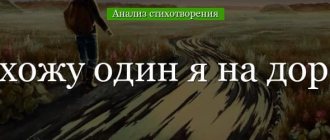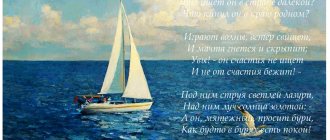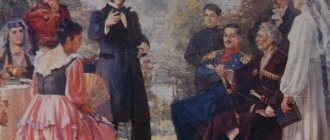History of creation
M. Yu. Lermontov wrote the poem “When the Yellowing Field is Worried” in 1837, while he was in prison. The text “The Death of a Poet” has just been published, which reflects the political views of the young Lermontov and, above all, harsh criticism of society and the system that led to the death of A. S. Pushkin. During the trial, it was decided to place Lermontov under arrest.
The story tells that the poet was forbidden to have paper and ink, so he wrote the poem with burnt matches and soot on the gray paper in which food was brought to him. It is noteworthy that it was in such conditions that Lermontov recalled the beauty and grandeur of nature and created a poem where every line breathes calmness and freedom.
It was published in 1840 in a collection of poems by the poet.
Artistic Features
The language of the poem is rich in adjectives, which fills the picture with the air of life, the almost physically tangible beauty of nature.
From a syntax point of view, the text is original: it consists of one complex sentence with several subordinate clauses (when..., when..., when...).
Each of the pictures of nature is the condition that allows the hero to feel a series of internal changes. Due to its dense syntactic structure, the text is perceived as a single exhalation, a spontaneous outburst of delight.
Genre, direction, size
- Traditionally, M. Yu. Lermontov is considered a romantic poet. The lyrical hero of his poem is lonely, cut off from the world of people and opposed to it. His ideal is perfect peace and harmony, and the unattainability of this ideal leads to spiritual quest and torment. It is in solitude that the hero enters into a dialogue with nature, comprehends its beauty and through it the power and greatness of the divine plan.
- The poem can be classified as both landscape and philosophical lyrics. The first stanzas paint successive pictures of nature: a cornfield, a forest, a garden and a ravine with a stream. In the last stanza, observation of the world around him leads the poet to philosophical generalizations; from dialogue with nature, he rises to knowledge of himself and God.
- The lyrical poem is written in iambic meter, mostly in hexameter, which helps Lermontov create a constant sense of movement. The movement stops only in the last shortened line, which becomes the final point of reflection.
- The rhyme also changes in the last stanza. The first three stanzas use cross rhyme, the last one uses ring rhyme.
Genre and size
The poem belongs to the landscape-philosophical lyrics. In the first two quatrains the poet paints natural beauties, and in the last he expresses his philosophical conclusions. There is also a plot. The genre of the poem is elegy. It refers to romanticism.
The lyrical work was written using iambic meter. Basically the poet used 6 feet, but in some lines the meter changes due to the words being too long. Due to this, the poem creates a feeling of perpetual motion. In the first and second stanzas the rhyme is cross, in the third it is circular.
Composition
The entire poem “When the yellowing field is agitated” is a period - one sentence.
- The first three stanzas begin with “when” and depict circumstances that push the hero to think. First we see a wide picture of field, forest and garden. Next, the focus narrows, we, together with the lyrical hero, admire a small silver lily of the valley, and then we go on a journey through the ravine and enjoy the babble of the icy stream.
- Pictures of nature seem to appear in separate bright flashes before the lyrical hero. If the first pictures are almost static, then in the third stanza a motive of movement appears: the stream tells a story about the region where it comes from, thus connecting together the entire natural and world space.
- Finally, the last stanza begins with “then” and sums up a certain conclusion, shifts attention from external details to the inner world of the hero and his thoughts. The peace and beauty of nature pacify his anxiety, smooth out wrinkles on his brow and help him come closer to understanding the design of the universe.
Poem composition
The poem is presented as a rhythmic period. It contains one complex idea. The verse consists of four quatrains. The first 3 stanzas lead to a philosophical conclusion, the hero’s recognition of what is going on in his soul. Each of them begins with the word “when” and describes the landscape in its own way:
- the first stanza tells about 3 human habitats in the surrounding world - forest, garden and field, each of them evokes admiration from the lyrical hero;
- in the second quatrain, the hero of the work describes a lily of the valley;
- the third quatrain is dynamic, it briefly shows the soul of the hero who admires the babbling spring.
For the character, nature offers opportunities to indulge in reflection.
The last stanza, unlike the previous ones, begins with the conjunction “then”. This is the main idea of the poem, because observing nature can give a person happiness and bring him closer to God. While in prison, Mikhail Yuryevich realized the beauty of freedom, because it gives you the opportunity to admire the world around you and love God.
Images and symbols
The lyrical hero of the poem “When the yellowing field is agitated” appears as a sensitive, deeply feeling person. He turns out to be capable not only of the “shadow of a sweet green leaf,” but also of seeing hidden facets, entering into a dialogue with the natural elements: greeting a “silver lily of the valley” or hearing a “mysterious saga” in the noise of a stream running down a ravine.
It is natural that nature in this poem is represented as a living, active force, which, like humans, is characterized by emotions and thoughts. The details of the usual Central Russian landscape, be it a yellowing field or modest wildflowers, for Lermontov become the embodiment of the earthly ideal of beauty. At the same time, the image of nature is drawn in a very three-dimensional manner and becomes a symbol of the perfection of the divine plan, all the individual parts of which are combined into a single canvas of the universe.
Means of expression
To give the poem brightness and uniqueness, Mikhail Yuryevich used many artistic techniques . Analysis of means of expression:
- Lermontov used a large number of epithets - “fresh forest”, “sweet shadow”, “raspberry plum”, “vague dream”, “mysterious saga”, “icy spring”, “fragrant dew”, “ruddy evening”, “silver lily of the valley” , “golden hour”, “peaceful land”. Due to this, the poem stands out significantly against the background of his other works of that time.
- The poet does not skimp on personifications - “when the exciting field turns yellow,” “the plum hides,” “the lily of the valley nods,” “the key plays and babbles.”
- Metaphors make the poem more voluminous and original - “anxiety is humbled,” “the wrinkles on the brow disperse.” With their help, you can clearly imagine what changes are happening to the hero, how his external and internal world is changing.
Lermontov chose the words very accurately, making the work melodic; the emotions and mood of the lyrical hero are conveyed through sounds. The poet used assonance and alliteration, which added musicality and airiness.
In the last quatrain, Lermontov drew syntactic parallelism between the first and second lines.
The poem written by Mikhail Yuryevich is a unique work with bright, unique images and deep philosophical thought. It was created in the best traditions of Russian landscape and philosophical lyrics.
Themes, mood and issues
The theme of the poem “When the Yellowing Field is Worried” has been narrowed by the Many-Wise Litrecon to the main truths, but if you need a more detailed explanation of this section, then write about it in the comments, and we will work together to supplement it.
- Scenery
. The main theme of nature is explored deeply and consistently in the poem “When the Yellowing Field is Worried.” Each stanza represents nature in its own way. Not only the location of the action changes, but also the time of day (“ruddy evening” and “golden hour of the morning”), the time of year (spring tender lily of the valley and autumn fields), that is, nature appears not static, but in constant motion, an ever-renewing element . - Search for harmony and faith
. Observation of nature and dialogue with it give the lyrical hero energy and strength for life, giving a feeling of happiness and freedom. The last stanza fully depicts the changes that have occurred. The inner world is transformed (“the anxiety of my soul is humbled”) and the very appearance of the hero (“the wrinkles on the forehead diverge”), he becomes able to look differently at the world around him (“and I can comprehend happiness on earth”) and rise to an understanding of the universe (“ and in heaven I see God"). - The mood of the poem
“When the yellowing field is agitated” conveys the author’s peace and enlightenment. Nature revealed to him the mystery of the universe and allowed him to see divine providence.
A brief analysis of the poem by M. Yu. Lermontov “When the yellowing field is worried”
Option 1
Mikhail Lermontov wrote this poem in 1837. It was at this time that he was imprisoned. The poet was arrested on March 4, 1837 for his poem “The Death of a Poet,” dedicated to Alexander Pushkin.
Lermontov had to pay for his work, since the poem reflected the political views of the poet. The story tells how, while in prison before exile, Lermontov wrote a poem that talks about nature. Moreover, the poem is written in such a way that freedom is felt in every line, in every word. Interesting fact: in prison, the poet could not have a pen and paper; he wrote with burnt matches on a food wrapper.
Even though the poem talks about nature, there is a philosophical thought here, and it is quite deep. The poet says that nature can bring peace, it calms. Being in nature, a person moves away from problems, he learns something greater than what surrounds him.
In nature, a person feels truly happy. Although some may classify the poem as landscape lyric, it is important to know that the poem is also a philosophical lyric.
Lermontov was able to masterfully express one moment in several stanzas; in this one moment he was able to reflect almost all the beauty of nature in different places: forests, gardens, streams. But the most important thing is hidden in the last stanza, when the author reveals the whole essence of the poem he wrote. “The anxiety of my soul is humbled”: the poet writes that nature calms and takes away problems. The poet then tells the reader in the poem that through nature one can know happiness in this world.
Lermontov's metaphors perfectly show us the greatness of nature. After all, anxiety itself submits to nature; it no longer dares to touch a person while nature is with him. “The wrinkles on the forehead are disappearing” - giving way to the happiness and peace that nature gives.
The poem also carries the meaning that nature pushes a person to think about something great. It is the very reason that allows a person to finally go beyond the boundaries of everyday consciousness.
Option 2
Poem by M.Yu. Lermontov’s “When the yellowing field is agitated...” refers to the original poetic works dedicated to the natural beauties of his native land.
This poetic miniature in form is one complex sentence with several subordinate clauses. The first three quatrains of the poem describe the moment at which the purification of the soul of the lyrical hero occurs.
Anxieties and worries go away “when the yellowing field is agitated and the fresh forest rustles at the sound of the breeze”, “when... the silver lily of the valley shakes its head in a welcoming manner”, “when the icy spring plays along the ravine.” The lyrical hero is internally calm when he is in the lap of nature, enjoys its beauty and feels part of the universe. Only such involvement with the natural world allows one to “comprehend happiness on earth” and see God in heaven.
The lyrical poem is rich in artistic and expressive means that depict the essence of true beauty. Poetic epithets create an atmosphere of quiet mystery: “under a sweet shadow”, “on a ruddy evening”, “in some vague dream”, “a mysterious saga”.
Artistic personifications make it possible to make the described picture come alive: “the yellowing field is agitated,” “the fresh forest rustles with the sound of the breeze,” “a raspberry plum is hiding in the garden,” “the silver lily of the valley shakes its head affably,” “the icy spring... babbles to me a mysterious saga about a peaceful land , from where he rushes." Nature, as it were, plays with the lyrical hero, revealing to him its unknown facets.
Lermontov's poem is filled with a feeling of peace, serene happiness, which is spilled in nature. And only after realizing this, the lyrical hero says:
Then the anxiety of my soul is humbled,
Then the wrinkles on the forehead disperse, -
And I can comprehend happiness on earth,
And in the heavens I see God...
This poetic miniature is the hero’s internal monologue. According to its mood, the poem by M.Yu. Lermontov’s “When the yellowing field is agitated...” is optimistic, as it allows the lyrical hero, and with him the reader, to see the highest truth.
— How do you understand what this poem by M.Yu. is about? Lermontov? (about the beauty and grandeur of nature)
— Why does the last line of the work talk about God? (God can be seen in the heavens if you learn to comprehend the secrets and beauties of nature.)
— Where, according to the poet, is harmony and beauty possible? (in nature)
Option 3
The work of Mikhail Yuryevich Lermontov is permeated with lyrics and descriptions of nature; most of all in his life he loved to visit the Caucasus.
In 1937, the idol of the entire literary world, Alexander Sergeevich Pushkin, died from a mortal wound received in a duel. Lermontov writes the poem “The Death of a Poet,” and by chance it falls into the hands of officials. For the harsh tone and hints at the murder of Pushkin in the poem, Lermontov was arrested and taken into custody in a St. Petersburg prison. It was there that the work “When the Yellowing Field is Worried” was published.
Having no writing instruments with him, Lermontov creates his last lyrical poem on a piece of paper with burnt matches and soot, and puts his whole soul into describing the splendor of his native land. It is the memories of nature and its beauty that help the poet withstand difficulties.
The poem is written in a complex sentence of 4 stanzas, which is not very typical for a poet, with indications of time, factor and state of mind. He wrote his work in a single impulse, hastening to express all his feelings and experiences, the longing for freedom and the injustice of the situation. The poet enters into a conversation with the divine principle, understands the essence of existence, it is this creation of the brilliant poet-lyricist that is considered the perfection of his work.
The description of nature is filled with epithets: ruddy evening, peaceful land, silver lily of the valley, mysterious saga, raspberry plum, these and other phrases show how well he felt the beauty of his native land.
The peace and tranquility of the entire work “... He nods his head affably” “... He babbles to me” is replaced by concern and anxiety in the last lines: “... the anxiety of my soul is humbled, ... the wrinkles on my brow disperse” the whole meaning of the poem and the tragedy of the situation become clear.
main idea
The meaning of the poem “When the yellowing field is agitated” is the transformation of a person through his contemplation of the beauty and grandeur of the surrounding world. Nature reveals its treasures to the lyrical hero, and it is this communication that becomes a source of strength and inspiration for him, allows him to feel the harmony of the world and join this harmony.
Outside observation very quickly turns into a dialogue with the natural elements, and this dialogue brings the hero closer to getting rid of anxiety, understanding himself and the ability to see the divine beginning of the world.
Let us remember that the poem was created by the poet during a period of imprisonment, when he was deprived of the opportunity to freely admire his native nature and draw strength from communicating with it. That is why the images created by imagination and memory turned out to be especially voluminous, and the main idea about the need for a connection with nature for a full life and understanding of the world sounds especially poignant.






